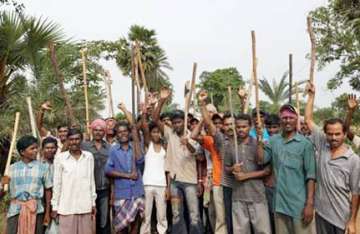Five attacks on security forces in six months. Thirty-two jawans killed, scores injured, arms looted, police patrols cowed. On the flip side, three crackdowns on Maoist dens. Just three suspected guerrillas killed, 190 arrested — 23 of them released to secure the freedom of abducted Sankrail OC Atindranath Dutta.
And the biggest fish — Maoist military strategist Kishenji — still at large.
It's clear how the scales are tipped in the tussle between Maoists and security forces in the tribal belt of Jangalmahal. The side that has the locals' support has the edge.
The Maoists started winning one battle after another after November 2008, when the People's Committee against Police Atrocities (PCPA) was formed. In January 2009, they started a police boycott in Lalgarh. With this began a systematic elimination of police informers, reports Times of India.
When the killing spree began, there were just 36 policemen in Lalgarh to police 300,000 people in 300 villages. It was the local information network that helped police in this impossible task. The guerrillas started targeting this system. Now, police stations are under lock-and-key and policemen don't dare to venture out after dark even if there is a murder.
The killings created a fear psychosis among the villagers, who retreated into a shell, refusing to share information with police. Occasional torture of villagers by police also turned people away from the lawkeepers.
This strategy helped Maoists create a “liberated zone”, which gradually spread beyond West Midnapore, to Purulia and Bankura.
The guerrillas also wooed villagers by digging wells, building roads and setting up health centres in this underdeveloped region. This helped them build a strong information system of their own that the forces do not have at the moment.
The forces take a share of the blame, as well. After nine months in the region, they are still to come to grips with the terrain. They are not aware of the village paths that crisscross jungles. Till the first week of February, they didn't even venture into the jungles, say sources, sticking to the roads for their 10 am to 3 pm patrols. In the past two weeks, they have started going into forests.
A CRPF jawan said the situation is getting worse. “We marched into Silda last night around 8.30 pm. Since then till this afternoon we couldn't even get water to drink. This is how we have been working every day,” he said.
But there are other equally worrisome questions that remain unanswered. Why were most of the jawans without arms? Why were the men and women who lurked in the area for more than an hour not challenged? Some sources claim that Kishenji himself had been keeping watch on the Silda camp for two months.
According to a CID official, it is high time the forces went for an “intelligence-backed guerrilla operation”. “You can beat guerrillas by fighting like a guerrilla. It's an ideal situation for Cobra operation under the direct command and control of CRPF.”
Latest India News
